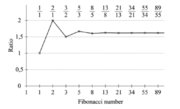History of the Golden Ratio
Throughout the generations, this Golden Ratio can be found in many areas in different perspectives, which explain why it goes by several names.
a. The uses date to the ancient Egyptians and Greeks
To begin with, in one of the Seven Wonders, the Egyptian Great Pyramid constructed in 2580-2560 BC, the Golden Ratio can be found: the ratio of the slant height of pyramid to half the base dimension is 1.61804, which is extremely close to the Golden Ratio. Greeks also showed the advanced understanding of the Golden Ratio. Phidias (500 BC – 432 BC), Plato (circa 428 BC – 347 BC), Euclid (365 BC – 300 BC), had put the ratio in their works. One of the example could be the Parthenon, one of the most famous buildings in Greece, whose shortest base length and the height form a Golden rectangle.
b. The Fibonacci Series was discovered around 1200 AD
Leonardo Fibonacci, an Italian born in 1175 AD (2) discovered the unusual properties of the numerical series that now bears his name. In 1202, with the reproduction of the rabbits, Fibonacci mentioned his sequence that had already been worked out earlier in the ancient Hindu Pignala ‘s Chandahsastra around 200 BC. The limit of the sequence produced by the quotients of the members of the well-known recursive Fibonacci sequence(Fn+2 = Fn+1+Fn, F0=1, F1=1)is equal to the Golden Ratio, that is Φ
c. The “Divine Proportion” in the 1500’s
During the Middle Age, this ratio was furtherly developed. Leonardo Da Vinci explored the human body involving in the ratios of the lengths of various body parts. He called this ratio the "divine proportion" and featured it in many of his paintings. This can be seen in the painting “The Last Supper”, from the dimensions of the table at which Christ and the disciples sat to the proportions of the walls and windows in the background. Johannes Kepler (1571-1630), German mathematician, astronomer, and astrologer, also made mention of the “Divine Proportion”.
d. The “Golden Ratio” was coined in the 1800’s and the symbol “ ("phi")” in the 20th century
The term "golden section" (in German, goldener Schnitt or der goldene Schnitt) seems to first have been used by Martin Ohm in the 1835 2nd edition of his textbook Die Reine Elementar-Mathematik (Livio 2002, p. 6). The first known use of this term in English is in James Sulley's 1875 article on aesthetics in the 9th edition of the Encyclopedia Britannica. The symbol ("phi") was apparently first used by American mathematician Mark Barr at the beginning of the 20th century in commemoration of the Greek sculptor Phidias (ca. 490-430 BC), who a number of art historians claim made extensive use of the golden ratio in his works (Livio 2002, pp. 5-6), as well as to commemorate Fibonacc, whose name’s first letter “F” is equivalent to Greek “Phi”.
e. Recent influence of Phi in modern math and physics
Phi is not resting to stimulate our understanding of the universe. In the early 1970’s, the asymmetrical surface with non-repeating manner in five-fold symmetry based on phi, was discovered by Roger Penrose, now known as “Penrose tiles”. It was found in 1980’s that the Quasi-crystals fill space with five-fold symmetry based on phi.


